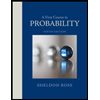ementary probability theory) the probability that the sum of the two dice will be each ot 2312. Use these probabilities to find the (true expected value and standard deviation of the sum of the two dice, and compare with the (sample) mean in cell J4; add to the spreadsheet cal- culation of the (sample) standard deviation of the sum of the two dice and compare with your exact analytical result for the standard deviation. 2. In the simulation of throwing two dice in Section 3.2.1, derive (from el- Keep the number of throws at 50. 3. Prove rigorously, using probability theory and the definition of the ex- pected value of a random variable, that in Section 3.2.2, E(Y) Ja h(x)da Start by writing E(Y) E(b a)h(X)] (b- a)E[h(X)], then use the definition of the expected value of a function of a random variable, and finally remember that X is continuously uniformly distributed on la, b] so has density function f(x) 1/(b- a) for a S x
ementary probability theory) the probability that the sum of the two dice will be each ot 2312. Use these probabilities to find the (true expected value and standard deviation of the sum of the two dice, and compare with the (sample) mean in cell J4; add to the spreadsheet cal- culation of the (sample) standard deviation of the sum of the two dice and compare with your exact analytical result for the standard deviation. 2. In the simulation of throwing two dice in Section 3.2.1, derive (from el- Keep the number of throws at 50. 3. Prove rigorously, using probability theory and the definition of the ex- pected value of a random variable, that in Section 3.2.2, E(Y) Ja h(x)da Start by writing E(Y) E(b a)h(X)] (b- a)E[h(X)], then use the definition of the expected value of a function of a random variable, and finally remember that X is continuously uniformly distributed on la, b] so has density function f(x) 1/(b- a) for a S x
A First Course in Probability (10th Edition)
10th Edition
ISBN:9780134753119
Author:Sheldon Ross
Publisher:Sheldon Ross
Chapter1: Combinatorial Analysis
Section: Chapter Questions
Problem 1.1P: a. How many different 7-place license plates are possible if the first 2 places are for letters and...
Related questions
Question
100%
Hi, I would like to see the steps and explanations for question 3. Thank you!
![ementary probability theory) the probability that the sum of the two
dice will be each ot 2312. Use these probabilities to find the (true
expected value and standard deviation of the sum of the two dice, and
compare with the (sample) mean in cell J4; add to the spreadsheet cal-
culation of the (sample) standard deviation of the sum of the two dice
and compare with your exact analytical result for the standard deviation.
2. In the simulation of throwing two dice in Section 3.2.1, derive (from el-
Keep the number of throws at 50.
3. Prove rigorously, using probability theory and the definition of the ex-
pected value of a random variable, that in Section 3.2.2, E(Y) Ja h(x)da
Start by writing E(Y) E(b a)h(X)] (b- a)E[h(X)], then use the
definition of the expected value of a function of a random variable, and
finally remember that X is continuously uniformly distributed on la, b] so
has density function f(x)
1/(b- a) for a S x <b.
4. Use QRISK, or another Excel add-in for static spreadsheet simulation, to
extend the example in Section 3.2.2 to 10,000 values of X,, rather than
just the 50 values in Model.03.02.x1s in Figure 3.2. Compare your results
to those in Mode1.03.02.xls as well as to the (almost) exact numerical
integral.
5. In the Monte Carlo integration of Section 3.2.2, add to the spreadsheet
calculation of the standard deviation of the 50 individual values, and use](/v2/_next/image?url=https%3A%2F%2Fcontent.bartleby.com%2Fqna-images%2Fquestion%2Fa75dfa91-23e0-4e51-aede-f9c93ee419b2%2F33288945-ed08-4d03-943a-3baf220ece05%2Fkw9akzs.jpeg&w=3840&q=75)
Transcribed Image Text:ementary probability theory) the probability that the sum of the two
dice will be each ot 2312. Use these probabilities to find the (true
expected value and standard deviation of the sum of the two dice, and
compare with the (sample) mean in cell J4; add to the spreadsheet cal-
culation of the (sample) standard deviation of the sum of the two dice
and compare with your exact analytical result for the standard deviation.
2. In the simulation of throwing two dice in Section 3.2.1, derive (from el-
Keep the number of throws at 50.
3. Prove rigorously, using probability theory and the definition of the ex-
pected value of a random variable, that in Section 3.2.2, E(Y) Ja h(x)da
Start by writing E(Y) E(b a)h(X)] (b- a)E[h(X)], then use the
definition of the expected value of a function of a random variable, and
finally remember that X is continuously uniformly distributed on la, b] so
has density function f(x)
1/(b- a) for a S x <b.
4. Use QRISK, or another Excel add-in for static spreadsheet simulation, to
extend the example in Section 3.2.2 to 10,000 values of X,, rather than
just the 50 values in Model.03.02.x1s in Figure 3.2. Compare your results
to those in Mode1.03.02.xls as well as to the (almost) exact numerical
integral.
5. In the Monte Carlo integration of Section 3.2.2, add to the spreadsheet
calculation of the standard deviation of the 50 individual values, and use
Expert Solution
This question has been solved!
Explore an expertly crafted, step-by-step solution for a thorough understanding of key concepts.
This is a popular solution!
Trending now
This is a popular solution!
Step by step
Solved in 4 steps with 4 images

Knowledge Booster
Learn more about
Need a deep-dive on the concept behind this application? Look no further. Learn more about this topic, probability and related others by exploring similar questions and additional content below.Recommended textbooks for you

A First Course in Probability (10th Edition)
Probability
ISBN:
9780134753119
Author:
Sheldon Ross
Publisher:
PEARSON


A First Course in Probability (10th Edition)
Probability
ISBN:
9780134753119
Author:
Sheldon Ross
Publisher:
PEARSON
